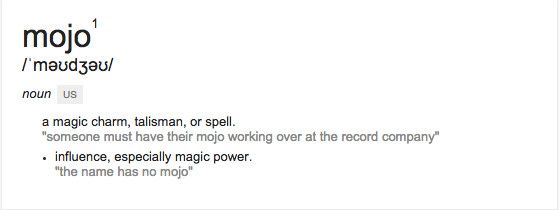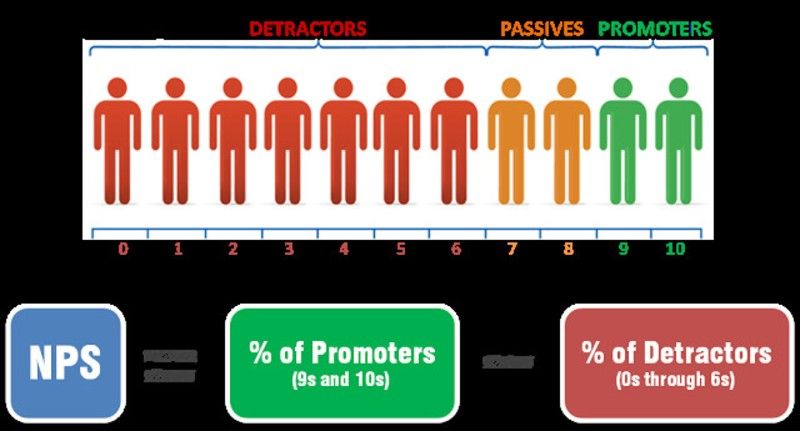It is every product manager’s dream that their users love their creation. Does your product have mojo?
Google defines mojo as follows:

Most analyse all sorts of metrics to see whether their product has got mojo. Some look at repeat visitation, user engagement, session time, organic growth, virality coefficient etc. These are all fabulous metrics and you can't live without them.
Yet, there is one super simple metric that tells you whether you have a product that users love.
It is called Net Promoter Score (NPS).
Users need to answer a single question that asks them if they would recommend your product. That's it. They give you scores ranging from 0 (worst, no way) to 10 (best, have asked my mom to buy it). Based on the rating, NPS can be calculated as:
NPS = Promoters [# of ratings of 9, 10]- Detractors [# of ratings 0 thru 6]/ Total

Source: https://ift.tt/2GLNrYa
Don't let the simplicity of the formula fool you. It is quite profound. And here's why:
It captures people that *love* your product less the ones that don’t. The key ingredient is Promoters who rate you 9 or 10. Those users don't just like your product; they don't just think it's cute; they don't just think it's a nice to have but they LOVE it and would put their stamp of approval, recommending it to their near and dear ones.
As soon as a user is willing to put themselves on the line for your product or service, you've got a winner. Users pay you for your product with money, time and trust. And when they are willing to evangelise your product, it's priceless!
Still not buying it? Well, think of how many products that you would recommend to others that you have used in the last month? Last year? Probably less than a handful. It is an elite, exclusive club.
Let me point out of some of the companies that have scored high NPS scores year after year. They include the likes of Nike, Apple, American Express, Costco, Netflix, Starbucks, etc. All these score over 60 percent on NPS. Some of them are over 70 percent. That's astounding. That's not just 60-70 people voting 9, 10. That's 60-70 *more* people voting at the highest level compared to people that vote 6 or lower. That's staggering. It is no surprise that these are legendary brands.
Does NPS have any correlation to the core business?
NPS has a direct impact on several business metrics. By definition, it is a measure of ‘Customer Satisfaction’. In many studies, customer satisfaction has shown itself to be directly correlated to revenue.
NPS has a direct correlation with your marketing effectiveness. It gives you an understanding of the otherwise fuzzy word-of-mouth quotient for your product. The higher the NPS is trending, the lower your cost of acquisition (CAC) should be.
It can also be a leading indicator for customer churn, which will have a direct impact on your revenue. Last but not the least, it helps you get a sense of the elusive Lifetime Value (LTV).
How and when should you measure NPS?
Just ensure you a pick a random, statistically significant set of users to poll. You need to pose this question to them right after they have experienced your product. It is important to ask them while the entire experience is fresh in their mind. That's it.
If you are an ecommerce portal, you might ask them right after they have bought something. If you are an airline, you might ask them right after they have completed a flight with you.
As for the frequency, you should do it with different cohorts ever so often. For most young companies, I recommend doing it monthly or quarterly. Don’t look at just the absolute score but look at how you are trending month on month.
Does NPS only work for B2C companies?
NPS can work for any company. It could be B2C, B2B, online, or even offline companies.
In fact, you can make this notion work for even your employment brand - aka employee NPS. Let’s say you survey your employees and ask them would they recommend this as a place for their friends to work? No wonder, companies that get most of their hires through referrals are often the best places to work at.
Where all can you apply NPS ?
Once you get the basic score, you can get quite granular with NPS. You can break it down to various parts of your experience. For example, you may ask how was our on-boarding or signup process? Or, how was the post sales process? How about the NPS for the call centre?
You may apply NPS to users acquired through different marketing channels. It may be interesting to see the NPS differences of users acquired from Facebook vs say Google or Apple.
One should view the NPS as a framework. You can define and apply in your business context as appropriate.
What is NPS not good for?
NPS is a great, simple, single metric for customer delight. NPS can act as a bellwether sign to the health of your product or service.
It does depend on effective and random sampling and hence may not be representative of all users. It is also not a replacement for any of your usual, granular marketing and product metrics. You still need to measure conversion rates, user engagement, referrals, user retention, etc.
Go ahead and implement NPS. It will take you little time to do it and give you a phenomenal return on investment. Use the NPS as leading indicator and in conjunction with your other metrics. Once you try it, I am confident you will be a promoter for NPS!
Edited by Teja Lele Desai
India’s most prolific entrepreneurship conference TechSparks is back! With it comes an opportunity for early-stage startups to scale and succeed. Apply for Tech30 and get a chance to get funding of up to Rs 50 lakh and pitch to top investors live online.
Link : https://yourstory.com/2020/10/net-promoter-score-metric-mojo-customer-experience-amit-somani
Author :- Amit Somani ( )
October 08, 2020 at 10:42AM
YourStory
